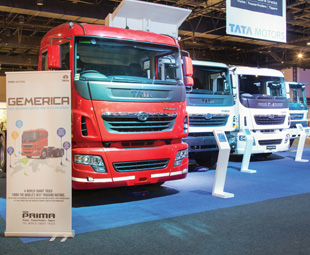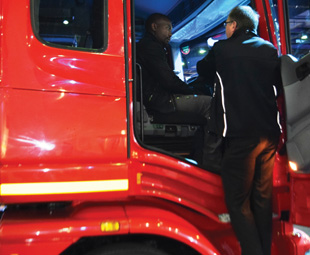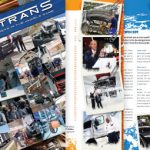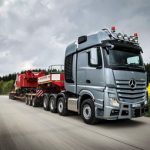Tata talk at TruckX

Tata featured strongly at the recent TruckX Expo Conference and Awards. We spoke to Harneet Luther, executive director at Tata Automobile Corporation South Africa, about his involvement in the road safety panel discussion and exhibition.
Safety was a key topic of discussion at the TruckX Expo – in more ways than one. In the first instance, the panel discussion on road safety raised some important points. Luther, who was one of the six participating speakers, agrees that this is a topic that requires unbridled attention.
“As mentioned by my co-panellist Johan Jonk, of Arrive Alive, 30 percent of traffic on the N3 highway is made up of trucks, but only nine percent of the accidents are caused by them. The balance is a result of other factors and we need to concentrate on all of these to solve the problem,” he says.
“A topic of this importance needs more time to be discussed in depth, and at least one or two people who make the regulations must attend then we can evolve the areas of discussion to the next level of action.”
 Indeed, as an industry, much is being done to combat the scourge of road crashes. As Paul Nordengen, principal researcher at the Council for Scientific and Industrial Research (CSIR) pointed out, there is no quick fix. However, self-regulation in the industry is helping us get to the goal more quickly.
Indeed, as an industry, much is being done to combat the scourge of road crashes. As Paul Nordengen, principal researcher at the Council for Scientific and Industrial Research (CSIR) pointed out, there is no quick fix. However, self-regulation in the industry is helping us get to the goal more quickly.
“The problem of road safety has to be tackled from different angles. The Road Transport Management System (RTMS) is one of the ways to solve the problem. RTMS tries to get operators to self-regulate and now has 8 000 trucks and buses in the programme. This is the tip of the iceberg, but statistics from these companies show a 50 to 60 percent reduction in accident rates,” he notes.
Themba Baloyi, founder and executive director of Discovery Insure, notes that the culture in South Africa needs to change. “We need to change people’s mindset. That’s when we see behavioural change. We have seen that people who drive better have vehicles that last longer. There’s a reduction in accidents, which increases profitability. These are not things that are just nice-to-have; business leaders need to use these tools at their disposal to make a difference.”
As Luther points out, these tools could even be the vehicles themselves, which is where the second example of safety comes in.
“As an industry we have started introducing more safety features to our vehicles. It’s important in terms of both saving lives and keeping fleet up-time to a maximum.
“At a hand over to an operator, we emphasise the various dos and don’ts for safe and economical operation of the vehicle. It’s a moral responsibility on our side and we try to encourage customers to have our consultants train their drivers. The operator is investing in an asset, which should not be spoiled by an untrained driver.”
 As such, Luther explains, at the Tata stand after the panel discussion, all the safety features that can save a vehicle from a crash have been incorporated in the new Tata Prima. After only eight months on the market, the Prima is also proving to operators that it is an economical and tough-as-nails vehicle.
As such, Luther explains, at the Tata stand after the panel discussion, all the safety features that can save a vehicle from a crash have been incorporated in the new Tata Prima. After only eight months on the market, the Prima is also proving to operators that it is an economical and tough-as-nails vehicle.
“Take up of the Prima has been excellent and we have seen repeat purchases. One customer ran a vehicle for over six months, 24-hours a day, for up to 5 000 hours in typical operation, which is the equivalent of 300 000 km in eight or nine months.
“The customers have confidence in the product and it has outperformed expectations. It’s a real value truck and the service that is expected is for us to back it up,” he says.
Madhu Singh, area manager – Southern Africa, Tata Motors elaborates. “At Tata we believe in ‘smart engineering’ – we don’t believe in over-engineering our products to the point that they become unaffordable to our customers and unviable in terms of cost per kilometre. That’s why the Prima is called the ‘World Smart Truck’.
“The biggest satisfaction for an OEM is customer loyalty. When a customer comes back to repurchase your product, you know you have a winner at hand, and that is what the Prima is!”
Needless to say, both Luther and Singh were happy with the attention both the Prima and the recently facelifted Novus V3TXF received at the exhibition. “Operators have seen the products on the road, which makes them feel comfortable to enquire about them. The financial options on the V3TXF and Prima also make them attractive to buy,” Luther says.
 For example, on the 75-t gross combination mass Novus V3TXF – with its Cummins 385 kW (480 hp) engine and Eaton UltraShift transmission – Tata offers, in association with Wesbank, a four-year rental scheme. For the operator, this means he has the security of a fixed monthly rental amount for a vehicle that is off the balance sheet.
For example, on the 75-t gross combination mass Novus V3TXF – with its Cummins 385 kW (480 hp) engine and Eaton UltraShift transmission – Tata offers, in association with Wesbank, a four-year rental scheme. For the operator, this means he has the security of a fixed monthly rental amount for a vehicle that is off the balance sheet.
Some of Tata’s valued customers were in attendance, too. Pim Pieterse, owner at D&H Plant and Machinery, has been running two of the new Primas, a single-axle horse and a 1518 roll-back. “We’re happy with them. There have been no problems, and we will buy more if we need to add to the fleet. The back-up and service from Tata is good, too,” he says.
Likewise, Tony Alexandra, dispatch fleet manager at South Ocean Holdings, comments that he has seven Tata’s in the South Ocean’s fleet and three in the sister company’s fleet.
“We took delivery of our first Tatas in January. We bought some four-tonne LPT813s, eight-tonne LPT1518s, a ten-tonne LPT1918, and a Prima horse. They deliver copper cables and electrical accessories, mostly running local routes with one or two to Polokwane and Nelspruit. They do so without the frills and get the job done! So far so good!” he says.
Says Singh: “Events like this are a good opportunity for the trucking industry to come together to showcase its products, collaborate with suppliers and network with customers. We need to win the hearts of customers! That is most important for us. If we can do that we have done our job!”
That is sure to make any operator feel safe.
Published by
Focus on Transport
focusmagsa




